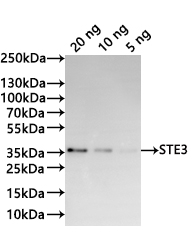STE3 Antibody
-
中文名稱(chēng):STE3 Antibody
-
貨號(hào):CSB-PA356936XA01SVG
-
規(guī)格:¥880
-
圖片:
-
其他:
產(chǎn)品詳情
-
產(chǎn)品名稱(chēng):Rabbit anti-Saccharomyces cerevisiae (strain ATCC 204508 / S288c) (Baker's yeast) STE3 Polyclonal antibody
-
Uniprot No.:
-
基因名:STE3
-
別名:Pheromone a factor receptor STE3 YKL178C
-
宿主:Rabbit
-
反應(yīng)種屬:Saccharomyces cerevisiae (strain ATCC 204508 / S288c) (Baker's yeast)
-
免疫原:Recombinant Saccharomyces cerevisiae (strain ATCC 204508 / S288c) (Baker's yeast) STE3 protein (286-470aa)
-
免疫原種屬:Saccharomyces cerevisiae (strain ATCC 204508 / S288c) (Baker's yeast)
-
標(biāo)記方式:Non-conjugated
-
克隆類(lèi)型:Polyclonal
-
抗體亞型:IgG
-
純化方式:Antigen Affinity Purified
-
濃度:It differs from different batches. Please contact us to confirm it.
-
保存緩沖液:Preservative: 0.03% Proclin 300
Constituents: 50% Glycerol, 0.01M PBS, pH 7.4 -
產(chǎn)品提供形式:Liquid
-
應(yīng)用范圍:ELISA, WB
-
推薦稀釋比:
Application Recommended Dilution WB 1:500-1:5000 -
Protocols:
-
儲(chǔ)存條件:Upon receipt, store at -20°C or -80°C. Avoid repeated freeze.
-
貨期:Basically, we can dispatch the products out in 1-3 working days after receiving your orders. Delivery time maybe differs from different purchasing way or location, please kindly consult your local distributors for specific delivery time.
-
用途:For Research Use Only. Not for use in diagnostic or therapeutic procedures.
相關(guān)產(chǎn)品
靶點(diǎn)詳情
-
功能:Receptor for the peptide pheromone a factor.
-
基因功能參考文獻(xiàn):
- no cryptic poly(A) sites are present in the a-factor receptor STE3 gene, indicating that S. cerevisiae has devised different strategies to regulate the two receptor genes STE2 and STE3 PMID: 21969566
-
亞細(xì)胞定位:Membrane; Multi-pass membrane protein.
-
蛋白家族:G-protein coupled receptor 4 family
-
數(shù)據(jù)庫(kù)鏈接:
KEGG: sce:YKL178C
STRING: 4932.YKL178C
Most popular with customers
-
-
YWHAB Recombinant Monoclonal Antibody
Applications: ELISA, WB, IHC, IF, FC
Species Reactivity: Human, Mouse, Rat
-
Phospho-YAP1 (S127) Recombinant Monoclonal Antibody
Applications: ELISA, WB, IHC
Species Reactivity: Human
-
-
-
-
-




















